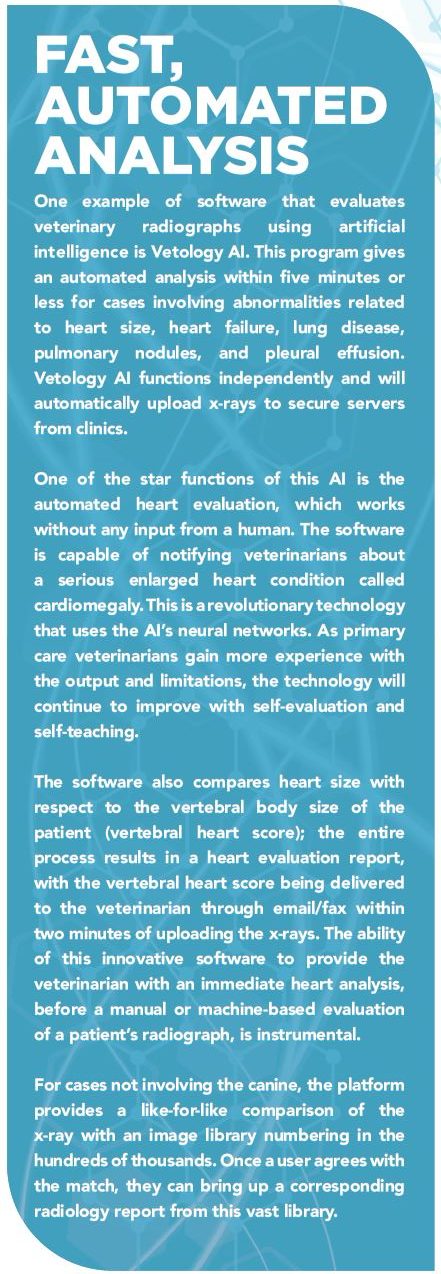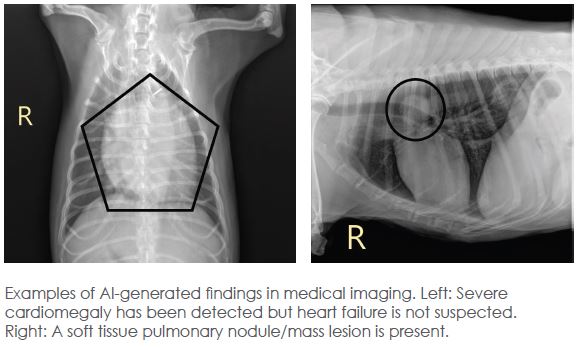Innovations in veterinary radiology: using AI to improve patient care
The implementation of artificial intelligence in the field of veterinary radiology allows doctors to receive crucial diagnostic information almost immediately.
The world of medicine is constantly changing, and the veterinary medical field is no different. Technology is advancing rapidly, and the rule is to adapt to these changes or succumb to the consequences. The use of artificial intelligence (AI) in veterinary radiology is a relatively new area. Leaders in this field are ethically responsible for providing correct product knowledge to the veterinary community, and should follow the principles of transparency, honesty, and integrity. At the same time, veterinary professionals eager to use this new technology must understand that the field is ever-evolving. As such, offered products will be in different development stages. Good Machine Learning Practices (GMLP) should be adhered to and documented.1
AI in veterinary medicine – potential areas of impact

Implementing an artificial intelligence strategy is a must for veterinary practices moving into the future. Access to specialists is not always available to hospitals or clients, and AI offers an attractive solution. However, experts believe that depending solely on AI can be detrimental. A strategic combination of both human competency and AI technology is important to drive the best care.
Some of the products related to AI in veterinary practice have already been in the marketplace for years. These are expected to gain immense popularity in the near future. The market for global wearable devices for the remote monitoring of pet health and activity is forecast to reach over $8 billion by year 2025.
When it comes to the human health market, similar products have gained in popularity. These are known for measuring simple parameters such as movement, heart rate, and body temperature. In addition, these devices keep tabs on food intake. They will make recommendations based on appropriate behavioral responses. For instance, these devices will inform diabetic patients about requirements for glucose or insulin.
New devices with the capability of measuring other important parameters will soon be available. In the veterinary field, cattle can be fitted with movement sensors to identify the onset of estrus. Similar technology will no doubt become available for other species, including pigs. At present, these sensors are quite expensive, especially for routine usage. Special efforts are being made to produce low-cost versions of the technology that would make them more accessible to farming operations.
This process will emulate the rapid decrease in the cost of genome analysis, resulting in possible developments of custom-made medicines in animals and human patients. Apart from identifying individuals with genotypes that may make them more or less vulnerable to the effects of specific drugs, professionals will also carry out genomic analyses on microbiome samples from the skin, gut, and other sites to evaluate which disease-causing organisms may exist in the patient’s body. There have been speculations on whether these approaches will ultimately lead to a reduction in the demand for antibiotics.
Advancements in monitoring technologies will similarly lead to challenges in processing and applying the available data. It is believed that doctors will have access to 200 times more data than the human mind can process. Consequently, another priority is the development of artificial intelligence software that analyzes this mass of information and draws precise conclusions about its meaning.

Google and Apple have special teams working on these issues. Significant development has already been seen; a team has produced diagnostic software that can easily identify human patients with early indications of diabetes. It is based on constant measurements of heart rate variation. This technology and others will change the way clinical practice operates.
Current applications
1. Medical imaging processing and assessment
The use of AI in this area includes quick yet precise and sensitive interpretations of radiographs, MRI images, CT scans, ultrasound images, and cytology assessments. At present, all aspects of AI are progressing exponentially, from computer processing power, speed, and affordability, to the development of machine vision reference directories. Hence, it is expected that most standard tasks involving clinical interpretation in veterinary practice will be allotted to AI. This will help veterinarians obtain quick, accurate, and detailed reports as well as consistency in interpretation, a factor that currently depends on the experience and skill level of the individual practitioner.
2. First-line primary consultations
This is another area where AI shows enormous potential. For human patients, smart kiosks are available that cut down on wait times, a major source of dissatisfaction among patients and stress for physicians. However, a combination of AI and detailed AR (augmented reality) instructions ensures a consistent, accurate, and detailed collection of crucial patient history and physical examination data. This is provided and collected by the patients themselves while they are guided through the entire procedure. After collecting the relevant data (usually completed in under 15 minutes), the doctor is sent a detailed patient work-up that includes a proper breakdown of predicted illnesses and treatment options. The medical practitioner then conducts a video consultation in order to confirm the authenticity of the AI-collected information, verify the diagnosis, and approve or alter the treatment plan. AI will also help maintain detailed and accurate healthcare records, and will automatically follow up with patients within a few days of the consultation.
Special efforts are being made to roll out veterinary-related versions of this system. Experts in the field believe that this technology will significantly augment the experience of clients and their pets. Implementation of this technology will also improve the professional lives of veterinarians, who face similar issues of stress and overload as their human physician counterparts.
Using artificial intelligence software provides an attractive option for all doctors, allowing them to receive crucial diagnostic information almost immediately.
Author disclosure statement: Eric Goldman is President of Vetology AI, a company that designs and delivers service innovation for the veterinary industry. He has a financial interest in Vetology Innovations LLC. For more information visit vetology.ai.
_______________________________
1American Association of Veterinary Radiologists guidelines, submission and review process for Veterinary Radiology Artificial Intelligence (AI) AAVR GMLP SaMD Product Certification — American Association of Veterinary Radiologists.

